Balcony Pepper Growing Guide: Step by Step: Getting a Good Harvest Without Leaving Your Home
To grow your favorite vegetables with your own hands, you do not need to have your own piece of land. You can create a small garden on the balcony. In specialized stores presented a large number of hybrids and varieties suitable for growing on the balcony and windowsill. Preference is given to compact, undersized and unpretentious crops.
Among the vegetables that are grownhut on the balcony, includes peppers, both sweet and bitter. For getenia goodhis harvestI am pepperimportant to consider requirements for the environment and soil, follow the rules of plant care and regularly apply top dressing to the soil.
The content of the article
What is needed to grow pepper on the balcony
To grow peppers on the balcony create for him comfortable conditions.
When choosing a place to grow washould considerthat this culture loves light and warmth. therefore for pepper, a balcony located on the south, east or west side is suitable. On the darkened side of the housedo additional lighting. The best option is a glazed balcony, it will protect the plant from drafts and temperature changes.
Council. On sunny days with high air temperatures, peppers need darkening, so it is advisable to curtain the windows on the balcony or install blinds.
Bitter pepper grow not only on the balcony, but also on the windowsill. The window must be southwest or east.
After choosing a place, we decide with pepper variety and studyaem step by step cultivation.
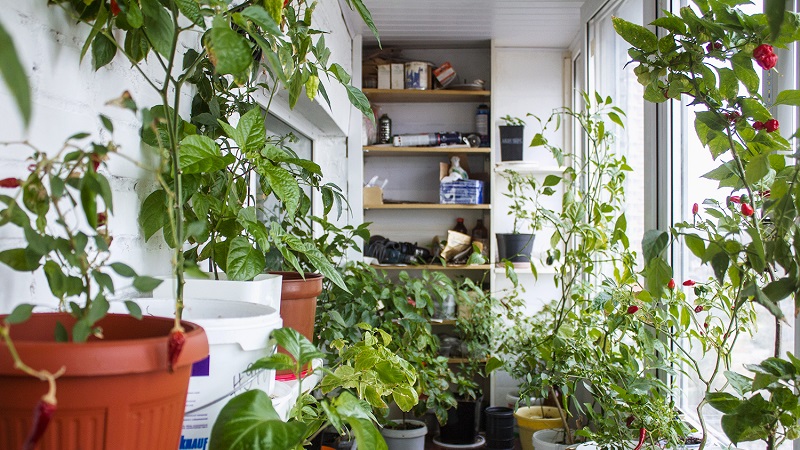
Growing features
Peppers are sweet and spicy. Cannot be grown on the same windowsill or balcony both kinds, since cross-pollination will occur during the flowering period, and all fruits will be bitter as a result. Growing different varieties on the balcony only, for example, sweet pepper, will not work either. Due to cross-pollination, their fruits will be of average shape, color, taste and smell. therefore opt for one variety or hybrid.
No matter what kind of pepper (hot or Bulgarian) you will grow, remembersethat the plant needs to be picked up:
- undersized (no more than 40-50 cm);
- with a compact root system;
- with a long fruiting phase;
- determinant, that is, it stops growing at a certain point.
Hot peppers are not too whimsical to grow. is he capable withstand the lack of water and light with virtually no loss. This balcony miracle not only bears fruit, but also serves as a decorative decoration. Small bushes with bright fruits decorate any interior.
Sweet peppers are more demanding to care for, but if favorable conditions are created for them, a rich harvest is guaranteed.
Attention! The taste qualities of peppers grown on the balcony are somewhat different from those that we are used to eating.
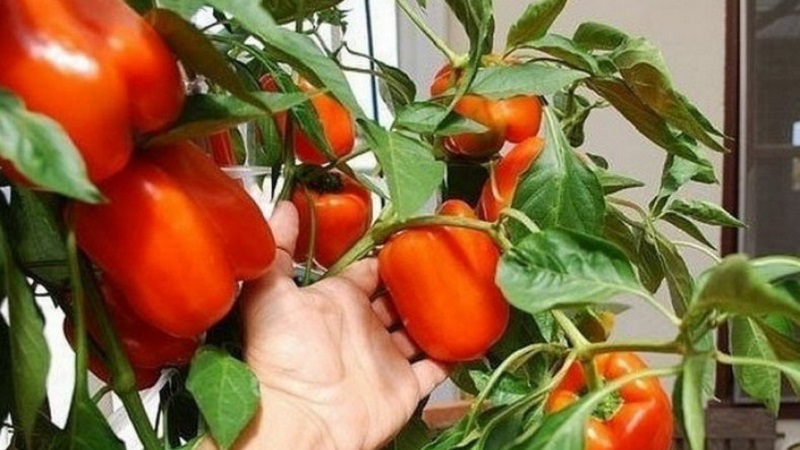
Balcony cultivars
A large number of varieties have been bred for growing pepper on a balcony or windowsill, which allows you to choose the best option. Mainth condition: the variety must be self-pollinatedm.
Sweet peppers suitable for balcony cultivation:
- Maikopsky 470 - highly productive variety. The ripening period is 110-120 days, the height of the bush is 35-45 cm, the fruits are pyramidal.
- Watercolor - early grade.The ripening period is 100-108 days, the height of the bush is 50-80 cm, the fruits are small, oblong.
- Winnie the Pooh - sweet early ripening variety (107-115 days). Large fruits of conical size, the height of the bush is no more than 30 cm.
- Mysterious island - an early ripe variety. Technical ripeness occurs on day 85. Compact bush, height - 40-60 cm, fruit in the form of a pointed cone.
- The firstborn of Siberia. Ripening rate - 108-113 days, bush height - about 50 cm, cone-shaped fruits.
- Dwarf - compactoh, determinantoh, bolesoh plantse... Height - 30-40 cm, inThe branchiness and leafiness are weak.
Among the best varieties of hot peppers are:
- Hungarian spicy - undersized plant. Yields up to 30 peppers per bush.
- Magic bouquet - mid-season variety. The height of the bush is 70 cm.
- Jalapeno Is a type of Mexican chili pepper with a special pungency. Perennial. There are several varieties of Jalapeno peppers: early, orange, purple, yellow.
- Hot cherry - small compact plant. The ripening period is 85-90 days.
- Habanero - one of the hottest peppers. It has a high yield, about 90 fruits are harvested from one bush.
Step by step instructions for growing
Growing pepper on the balcony requires adherence to certain rules.
Site and container preparation
If a for growing sharpwow pepperenough window sill, then a glazed balcony is preferable for sweet pepper. Choose the most illuminated place, which is equipped with shelves or shelves. Fit and mini greenhouses designed for balconies. In early spring, when the air temperature is low, they are used to grow seedlings. In the summer, the film cover is removed, and the mini-greenhouse serves as a rack for plants.
For planting pepper seeds, use plastic cups, small containers or boxes.
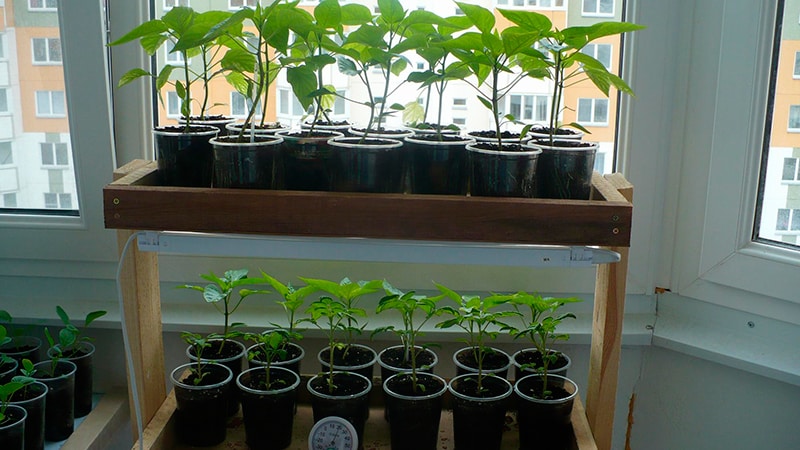
Seed preparation
Since peppers have a long growing season, it is better to start planting in the first decade of February if you plan to grow on a glazed balcony. If the balcony is not glazed, the optimal disembarkation time is the first decade of May.
Sowing seeds hot pepper start already in January.
For disinfection, the seed is soaked for 3 hours in a weak solution of potassium permanganate (1: 1000). For planting, take the seeds that have sunk to the bottom, discard those that have emerged.
Then the seeds should be slightly dried and soaked in a growth stimulatorand "Epin" (1 drop per 100 ml of water) or "Zircon" (1 drop per 300 ml of water) for 18 hours.
After that, the planting material is folded into a white cotton cloth folded in several layers and soaked in water. The tissue is tied in a knot and placed in a plastic bag, which is left in a warm place. After three days, the seeds are checked: if less than half hatched, the bundle is left for another 1-2 days.
After germination, the seeds are hardened by placing them on the bottom shelf of the refrigerator for 3 days.
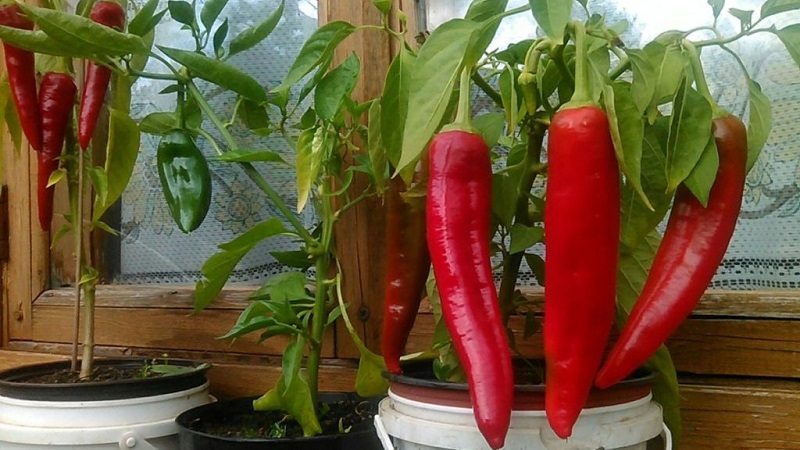
Soil preparation
Pepper loves loose, nutritious soil with low acidity (pH in the range of 6.0-7.0). To reduce acidity, into the groundadd lime or dolomite flour. The soil acquire ready-made or independentlymix sod land, sand and humus in a 2: 1: 1 ratio. Before planting seeds, the soil is disinfected. To do this, spill it with boiling water, and then allow it to dry out a little, or ignite it in an oven at 200 ° C for 10 minutes.
Landing
At the bottom of the prepared container, a drainage layer (fine expanded clay, coarse sand) is poured, then the soil is poured. The soil is spilled with warm water, in case of shrinkage, more is added.
Place two seeds in a plastic cup at a distance of 2-3 cm to a depth of 1 cm. When sowing in a box, grooves are made 1 cm deep at a distance of 4 cm from one another, the interval between the seeds is 3 cm. The seeds are covered with earth, the container is covered with a film.
The seeds are germinated at a temperature of 23-25 ° C. With the appearance of the first shoots, the film is removed and the seedlings are transferred to a bright place.The temperature is reduced to 18 ° C for 5-7 days to harden the plant. Then the optimum temperature is set.
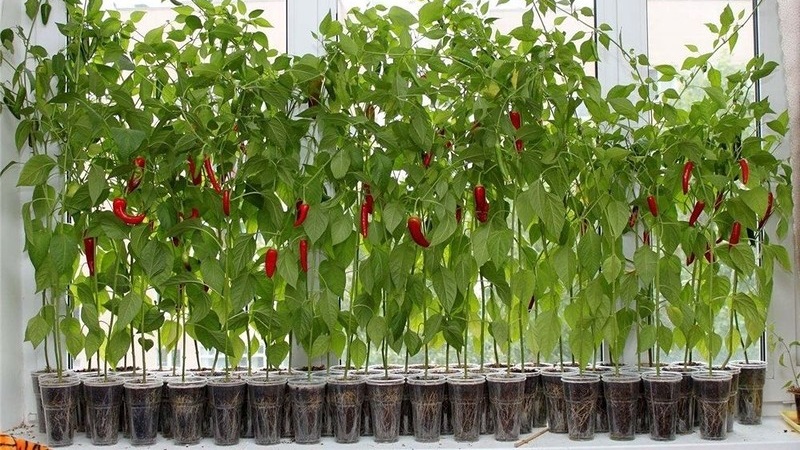
Care
In order for a full-fledged seedling to grow, and subsequently a healthy plant that bears fruit, follow the rules of care.
Transfer and picking
After 3-4 weeks the peppers transplanted and pikircosiness. To do this, prepare a container: boxes for 2 plants or separate pots with a capacity of 2 liters. Drainage is poured at the bottom of the dishes, then soil (garden soil, sand, peat in equal proportions). The earth is moistened and a hole is made for the plant.
Reference.It is better to transplant peppers on a cloudy day, or preliminarily darken window.
Two hours before transplanting, the seedlings are irrigated. One seedling is planted in a pot. In the box, the distance between the plants is at least 30 cm.
The seedling is pryed along with a layer of earth, the root is carefully cut off to no more than ¼ of the length. The plant is placed in a new container so that the main root does not bend, and the leaves rise 15-20 mm above the ground. The soil is crushed.
Within 2-3 days recommended maintain temperature conditions within 19-21 ° С. Lower temperatures can cause blackleg formation and the plant will die. To prevent root rot required to comply moderate humidity.
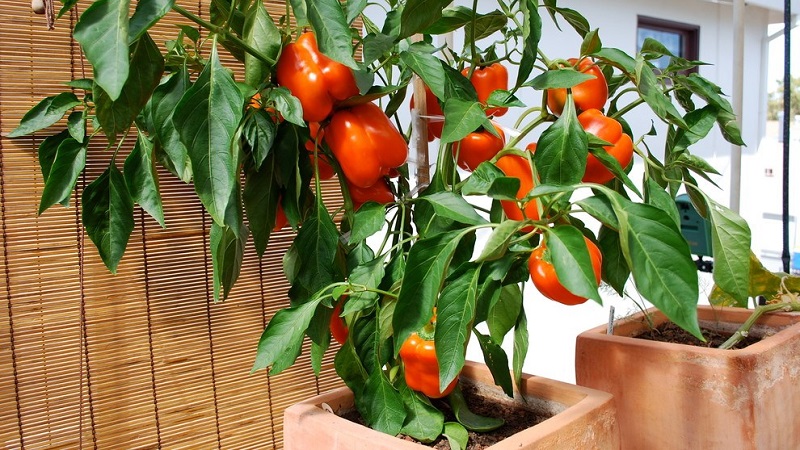
Care requirements
For normal growth and development of pepper important maintain the temperature regime. For bell peppers, the optimal daytime temperature is 22-27 ° С, the nighttime temperature should not fall below 17-19 ° С. The optimum temperature for growing hot peppers: in winter - from 16 to 18 ° С, in summer - from 22 to 25 ° С.
Lack of lighting should compensate for additional illumination (phyto or fluorescent lamps).
Pepper loves moisture. If the air in the room is dry plants additionally sprayinghut... Watered with warm water in small portions. During the flowering period and the formation of the ovary, about 1 liter of water per day goes to the bush, in hot weather - up to 2 liters.
To keep moisture in the soil, mulch. But loosening is better not to be carried out or done carefully so as not to damage the roots.
The peppers are fed three times during the growing season: a week after planting the seedlings, during flowering and during the formation of the first ovary Complex fertilizers are used for vegetable crops. Also do additional feeding: during the flowering period - with potassium fertilizers and succinic acid, during the period of ovary appearance - fertilizers with phosphorus.
To form a bush exist a number of rules:
- stepchildren growing from the axils of the leaves are removed;
- leaves growing below the first branch are removed;
- the formation of a bush occurs only from two shoots;
- the first flowers are removed at the bud stage;
- on a weak branch, pinch the crown over the first ovary;
- to stop the growth of the plant and to allow the formed ovaries to develop, pinch all the tops a month before the end of the growing season.
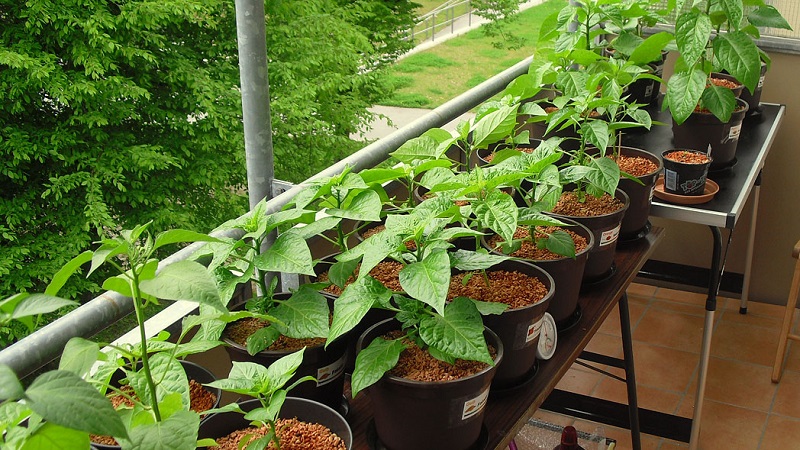
Diseases and pests
Zgreen aphid - one of the main pests of pepper. ABOUTusually flies from the street. To get rid of from her, plant washed with a stream of water.
If a cobweb appeared on the bushes, it means that he was attacked spider mite... In this case, the plants washed a solution of laundry soap (1 bar of soap per 10 liters of water), and the earthYu polyare a weak solution of potassium permanganate (1 h. l. for 1 liter of water).
The curling of the leaf and the appearance of a purple tint on it indicates a lack of phosphorus. Small grayish foliage indicates a lack of nitrogen. If the leaf is curled and the edges become dry, then there is not enough potassium. Should feed with phosphoric acid, ammonium or potassium nitrate.
White dots on the leaves appear when moisture stagnates, meanswatering should be reduced.
Reference.With proper seed preparation and plant care, balcony peppers are practically not affected by diseases and pests.
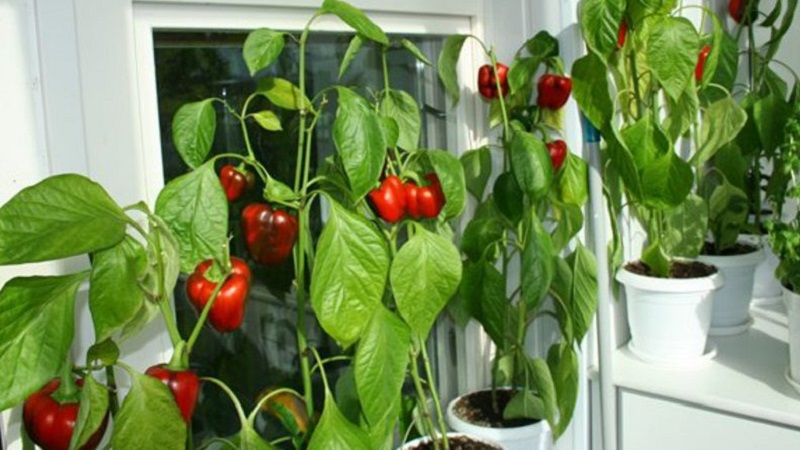
Harvesting and storage
The peppers are harvested as they ripen. The ripe ones are cut off, not broken off.
A few bell pepper bushes grown on the balcony will not yield a harvest, sufficient for blanks and conservation. But diversify the daily diet with fresh vegetables.
And here is the hot pepper will be delight with the harvest from late spring to December. Some varieties bring up to hundreds of fruits. Hot peppers are harvested when it ripens, that is, it turns orange, red or yellow.
Hot peppers are kept in boxes whole pods, dried. Or they grind and fall asleep in jars. Another option is in vegetable oil. Pwashed pepper put into a glass bottle and pouredare refined oil. After 1-2 months, a fragrant tincture is obtained.
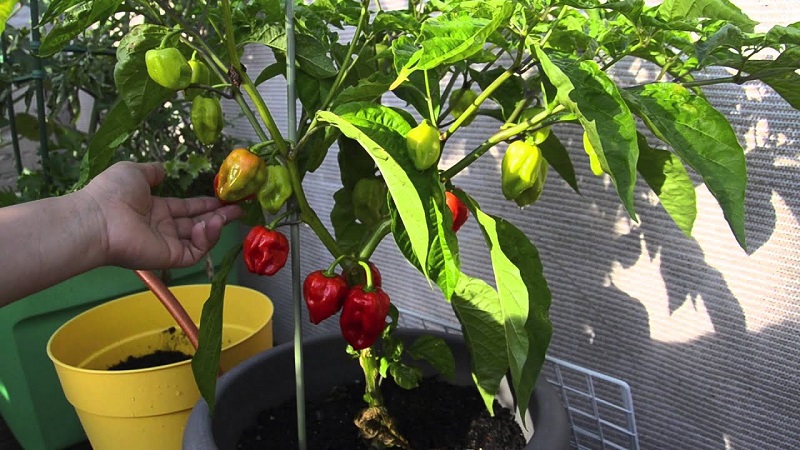
Conclusion
Pepper is considered a whimsical culture. He reacts sharply to the lack of the necessary conditions for growth. Growing peppers on a balcony is not easy, but quite possible. For this should take into account the peculiarities of growing sweet and hot peppers, choose and equip the place correctly, choose the variety correctly and comply with all agrotechnical requirements for preparation and care.